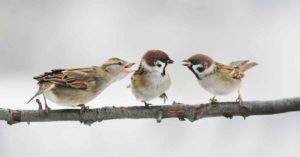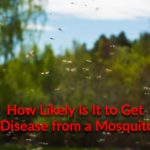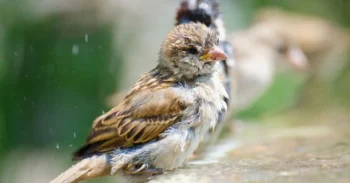
 Wild birds belong outside, not in your home, and some you might not even want on your property. Between the mites they carry and some being aggressive, birds can cause complicated issues.
Wild birds belong outside, not in your home, and some you might not even want on your property. Between the mites they carry and some being aggressive, birds can cause complicated issues.
House Sparrow & Tree Sparrow: What’s the Difference?
House sparrows are slightly bigger than tree sparrows. House sparrows tend to be more versatile eaters. In addition to seeds, they will forage food from trash cans and picnic areas. That tendency also makes house sparrows more common in urban areas than tree sparrows.
Both types of sparrows are often placed in the “small brown birds” category. Male house sparrows have a light gray crown, black throats and upper chests, and black around their eyes. Female house sparrows also have black throats and black around their eyes but a buff-colored crown instead.
Tree sparrows look reddish-brown and gray with a rusty cap and rusty color around their eyes with an otherwise gray head. Both male and female tree sparrows have a breast that ranges from buff-colored to gray. These small birds tend to puff out their feathers, which makes them seem plumper than they actually are.
Are House Sparrows Bad?
House sparrows have been found on every continent – including Antarctica. And they have also been pests wherever they go.
While cute, house sparrows are not as harmless as they seem. They are actually an invasive species, causing a substantial amount of property damage. These sparrows originally spread as humans did because following settlements provided house sparrows with access to food.
Unfortunately, house sparrows live up to their names… frequently finding their ways into buildings of all types, from homes to businesses. They are also aggressive, frequently chasing away song birds.
House sparrows can be destructive in creative ways. They’ve been known to tightly pack their nesting material into fan vents, dryer vents, stoves, and chimneys causing fire hazards. They also do the same to gutters, downspouts, drains, and more.
House sparrows can even damage cars. Their droppings contain uric acid, which erodes automobile paint and other building materials. To make things worse, they also carry mites and pathogens that can cause disease.
Are Bird Mites Dangerous?
Bird mites can be dangerous but not as dangerous as other parasites and pathogens carried by birds. Bird mites live on the skin of various birds, including chickens. From the birds, they can migrate into homes that birds perch on or infest.
Bird mites can bite humans, and the bite area will look like other insect and mite bites. Red bumps can also occur, as can a crawling sensation or itching.
The most dangerous part of a bird mite bite is if it becomes infected. The symptoms of infection include:
- Pain
- Redness
- Pus or discharge
- The bite area is warm
- Soreness
Call Arrow For All Your Bird Problems
If you have a bird problem on your property, call in the professionals at Arrow Exterminating. The sooner you contact us, the sooner we can help. To get started, contact Arrow Exterminating today.




